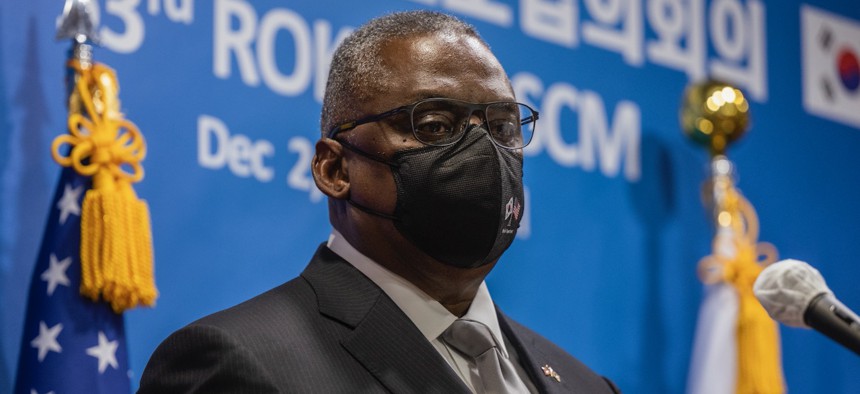MARCUS WEISGERBER and TARA COPP

SIMI VALLEY, CALIFORNIA — U.S. Defense Secretary Lloyd Austin cautioned national security leaders and industry executives against over-hyping recent Chinese weapons tests—but also called for deeper ties between the Pentagon and large and small technology companies to counter China.
In a Saturday speech titled “The China Challenge” at the 2021 Reagan National Defense Forum, a gathering of defense leaders, lawmakers, and private industry executives here, Austin said China’s recent hypersonic launch and its gains in nuclear weapons, cyber, and space should be met “with confidence and resolve—not panic and pessimism.”
“We’re clear-eyed about the challenge that China presents, but China’s not 10 feet tall,” Austin said after his speech in a discussion with Fox News’ Bret Baier. “This is America. We have the greatest industry, the greatest innovators in the world and we’re going to do what’s necessary to create the capabilities that help us maintain the competitive edge going forward.”
Yet some of the Pentagon’s most senior uniformed leaders used the same forum to paint a dark picture. Just before Austin spoke, Indo-Pacific Command head Adm. John Aquilino said at a panel discussion that China’s activity in the Pacific was the biggest military buildup the world had seen since World War II. Space Force Vice Chief of Operations Gen. David Thompson said China could exceed U.S. military capabilities by 2030.
“They are building and fielding and updating their space capabilities at twice the rate we are,” Thompson said. “It means that very soon, if we don’t start accelerating our development and our capabilities, they will exceed us, and 2030 is the point in which that could occur if we don’t adjust.”
Still, Austin warned that China is building a “nascent nuclear triad,” referring to nuclear weapons that could be launched from bomber aircraft, submarines, and intercintinental ballistic missiles.
“We’ve got to be clear about the China challenge, and about what we need to do to meet it,” he said.
One of those things is finding better ways to harness America’s tech industry, Austin said, echoing predecessors in the Obama and Trump administrations who launched numerous efforts to help start-ups and commercial technology firms to compete for defense business.
“Let’s face it, for far too long, it’s been far too hard for innovators and entrepreneurs to work with the department,” Austin said “The barriers for entry into this effort—to work with us in national security—is often too steep, far too steep.”
Austin pledged to “double down” on the Pentagon’s Small Business Innovation Research program, saying the Defense Department has “awarded funds to more than 2,500 small businesses working on groundbreaking tech.” The Pentagon has also increased the number of its regional Defense Innovation Unit outposts.
In recent years, the Pentagon has opened up DIU offices in Silicon Valley, California; Austin, Texas; and Boston. Last month, Heidi Shyu, defense undersecretary for research and engineering, said the Pentagon would open a DIU regional hub in Chicago. On Saturday, Austin said another DIU office was “recently opened” in Seattle, home to Microsoft and Amazon.
“The goal here is simple: to connect with new talent who will help us compete and win, on challenges from countering [drones] to responsibly leading the [artificial intelligence] revolution,” he said.
Large defense firms have been forming their own alliances with commercial technology companies. Lockheed Martin, the world’s largest defense contractor, recently formed a partnership with telecom giant Verizon to develop 5G technology for the military.
Austin also called for help in moving research projects into full-scale production, a feat defense insiders call “crossing the valley of death.” Congress has taken steps in recent years to shepherd new types of technology to the battlefield.
“We can’t just keep funding programs and platforms that will be irrelevant,” he said. “We must streamline the acquisitions process or we’ll tie one arm behind our backs.”
Austin also touted the creation of the Rapid Defense Experimentation Reserve, which aims to move tech more quickly from the laboratory to the battlefield.
“It helps identify our most pressing capability gaps and makes funds available to test new technologies that could be game-changers,” he said. It lets the Army, the Navy, the Air Force, the Space Force, and the Marine Corps try out innovative tech together at scale for the first time.”
Austin also called for “deepening our R&D relationships with our regional allies and partners” in the Indo-Pacific.
No comments:
Post a Comment